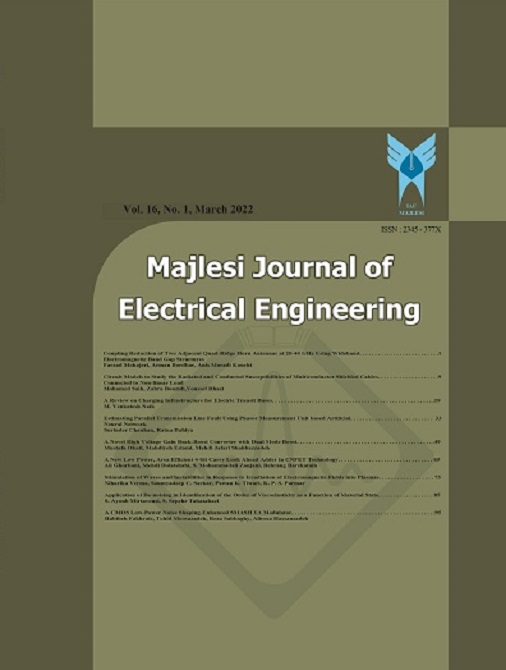Document Type : Reseach Article
Authors
Department of Electrical Engineering, Faculty of Electrical and Electronic Engineering, Universiti Tun Hussein Onn Malaysia, Batu Pahat, Johor, Malaysia.
Abstract
This paper focuses on the development of a Graphical User Interface (GUI) and Artificial Neural Network (ANN) for the prediction of photovoltaic (PV) power output. PV power is generated based on the time, location, and surrounding climate conditions. Therefore, solar power generation predictions using computational methods are needed since the changing weather, which will impact the output power will not generate according to its rating. The objectives of this research are to predict photovoltaic power output at Universiti Tun Hussein Onn Malaysia (UTHM), develop an ANN configuration that can perform the prediction of solar power generation, and design GUI system that can both perform the calculations of power generation and ANN. In order to test the efficiency and reliability, MATLAB software has been used to develop the GUI and ANN, and the output is compared with the proposed mathematical equations. The real data as input data was obtained from the PV solar panel located at GSEnergy Focus Group fertigation site. The GUI with user-friendly features and ANN have been successfully designed and developed which can perform daily prediction of solar power output. On top of that, the results have shown that the ANN predictions are more precise to the real data than the GUI.
Keywords
- [1] Azman, A. A. Rahman, N. A. Bakar, F. Hanaffi, and A. Khamis, “Study of renewable energy potential in Malaysia,” in 2011 IEEE 1st Conference on Clean Energy and Technology, CET 2011, 2011, pp. 170–176, doi: 10.1109/CET.2011.6041458.
- [2] Nandhini, K. Bharathi, S. Giri, S. Sowvav, and A. Suyampulingam, “Energy management and smart control of home appliances,” J. Phys. Conf. Ser., vol. 1706, no. 1, 2020, doi: 10.1088/1742-6596/1706/1/012087.
- [3] Zaharim et al., "Public acceptance on stand-alone renewable energy project in rural area of Malaysia," 2017 International Conference in Energy and Sustainability in Small Developing Economies (ES2DE), 2017, pp. 1-7, doi: 10.1109/ES2DE.2017.8015349.
- [4] Iqbal, M. D., & Rizvi, I. A. (2019). “Design of PVT System for Typical Indian Village and its Analysis for the Reduction of Co2 Emission.” International Journal on Recent and Innovation Trends in Computing and Communication, 7(6), 44–47. E. Clarke, Circuit Analysis of AC Power Systems, vol. I. New York: Wiley, 1950, p. 81.
- [5] Setyawati, H., Murwani, I. K., Darmokoesoemo, H., & Permana, A. J. (2023). “Photovoltaic Performance of Naphthol Blue Black Complexes and their Band Gap Energy.” International Journal of Nanoelectronics and Materials, 16(2), 335-344.J. Jones. (1991, May 10). Networks. (2nd ed.) [Online]. Available: http://www.atm.com
- [6] Kashani, Marziyeh, et al. "The Optimization of Photovoltaic Systems Design Using Mathematical Modeling and QFD-DSM Methods." Majlesi Journal of Electrical Engineering2 (2022): 55-72.
- [7] gov.my. (2020). FiT – Renewable Energy Malaysia. [online]
- [8] Kumar, “Social, Economic, and Environmental Impacts of Renewable Energy Resources,” in Wind Solar Hybrid Renewable Energy System [Working Title], IntechOpen, 2020.
- [9] Mishra, Vijay Laxmi, Yogesh K. Chauhan, and Kripa S. Verma. "Various modeling approaches of photovoltaic module: A comparative analysis." Majlesi Journal of Electrical Engineering2 (2023): 117-131.
- [10] Premalatha, N., & Valan Arasu, A. (2016). “Prediction of solar radiation for solar systems by using ANN models with different back propagation algorithms.” Journal of applied research and technology, 14(3), 206-214.
- [11] BEKTAŞ, Sibel ÇEVİK, Recep Cakmak, and İsmail H. ALTAŞ. "Design of a MATLAB GUI for day ahead forecasting of PV panel power." 2019 Innovations in Intelligent Systems and Applications Conference (ASYU). IEEE, 2019.
- [12] Liu, Shicheng, Ruidong Chang, Jian Zuo, Ronald J. Webber, Feng Xiong, and Na Dong. "Application of artificial neural networks in construction management: Current status and future directions."Applied Sciences 11, no. 20 (2021): 9616.
- [13] PEAK DUO SERIES MODEL 395 - 415 Wp | 132 Cells 21.1 % Maximum Module Efficiency The ideal solution for: Rooftop arrays on residential buildings Extreme weather rating.
- [14] Sustainable Energy Development Authority (SEDA MALAYSIA), Chapter 3: Photovoltaic Technology, page 49. September 2016. (ISBN 978-967-10942-7-3).
- [15] Franklin, E. A. (2019). “Calculations for a Grid-Connected Solar Energy System.” University of Arizona Cooperative Extension: Tucson, AZ, USA, 2-6.
- [16] Mayer, M. J., & Gróf, G. (2021). “Extensive comparison of physical models for photovoltaic power forecasting.” Applied Energy, 283, 116239.
- [17] Liu, L., Zhao, Y., Chang, D., Xie, J., Ma, Z., Sun, Q., & Wennersten, R. (2018). “Prediction of short-term PV power output and uncertainty analysis.” Applied energy, 228, 700-711.

